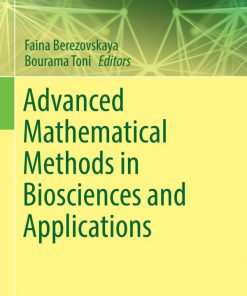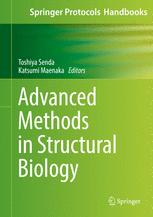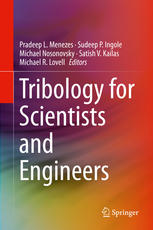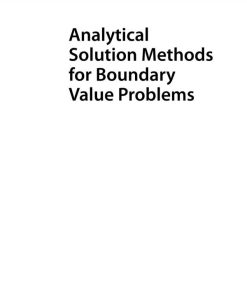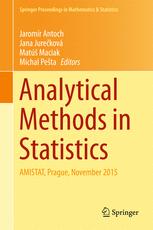Advanced Analytical Methods in Tribology 1st Edition by Martin Dienwiebel, Maria Isabel De Barros Bouchet ISBN 9783319998961 331999896X
$50.00 Original price was: $50.00.$25.00Current price is: $25.00.
Advanced Analytical Methods in Tribology 1st Edition by Martin Dienwiebel, Maria-Isabel De Barros Bouchet – Ebook PDF Instant Download/Delivery: 9783319998961, 331999896X
Full download Advanced Analytical Methods in Tribology 1st Edition after payment
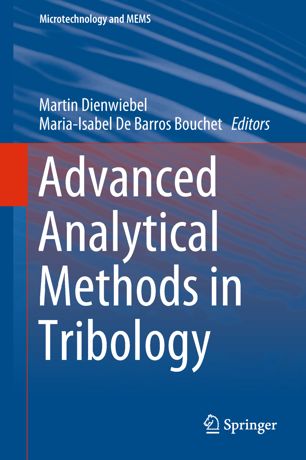
Product details:
ISBN 10: 331999896X
ISBN 13: 9783319998961
Author: Martin Dienwiebel, Maria-Isabel De Barros Bouchet
This book presents the basics and methods of nanoscale analytical techniques for tribology field. It gives guidance to the application of mechanical, microstructural, chemical characterization methods and topography analysis of materials. It provides an overview of the of state-of-the-art for researchers and practitioners in the field of tribology. It shows different examples to the application of mechanical, microstructural, chemical characterization methods and topography analysis of materials. Friction and Wear phenomena are governed by complexe processes at the interface of sliding surfaces. For a detailed understanding of these phenomena many surface sensitive techniques have become available in recent years. The applied methods are atom probe tomography, in situ TEM, SERS, NEXAFS, in situ XPS, nanoindentation and in situ Raman spectroscopy. A survey of new related numerical calculations completes this book. This concerns ab-initio coupling, numerical calculations for mechanical aspects and density functional theory (DFT) to study chemical reactivity.
Table of contents:
Part I: Microstructural Characterization
1. Electron Microscopy and Microanalysis for Wear Surface Characterization
1.1 Introduction
1.2 Focused Ion Beam Preparation and Scanning Electron Microscopy
1.2.1 Focused Ion Beam (FIB) Preparation of Samples
1.2.2 Electron Backscatter Diffraction and Transmission Kikuchi Diffraction
1.3 Transmission Electron Microscopy and Microanalysis
1.3.1 Transmission Electron Microscopy
1.3.2 Scanning Transmission Electron Microscopy
1.3.3 Microanalysis
1.3.4 Spectral Image Analysis
1.3.5 Multivariate Statistical Analysis
1.4 Tribology Case Studies
1.4.1 Diamond-Like Carbon Coating Characterization
1.4.2 Wear-Induced Recrystallization
1.4.3 Tribology of Nanocrystalline Metals
1.4.4 Transition Metal Dichalcogenides
2. Analyzing Mild- and Ultra-Mild Sliding Wear of Metallic Materials by Transmission Electron Microscopy
2.1 Introduction
2.1.1 TEM Analytics of the Cyclic Strain Gradient
2.1.2 TEM Analyses of the Tribomaterial
2.1.3 Wear Particle Analyses by TEM
2.2 Conclusions and Outlook
Part II: Tribochemical Characterization Techniques
3. Near Edge X-Ray Absorption Fine Structure Spectroscopy
3.1 Introduction
3.2 Principles of Near Edge X-Ray Absorption Fine Structure (NEXAFS) Spectroscopy
3.3 Experimental Methods in NEXAFS Spectroscopy
3.3.1 Data Acquisition
3.4 Applications of NEXAFS Spectroscopy
3.4.1 Investigation of Thin Films for Tribological Applications
3.4.2 Structural Evolution of Solid Lubricating Films
3.4.3 Tribochemistry of Solid Lubricants
3.5 Conclusions
4. Tribochemistry of n-Alkane Thiols Examined by Gas-Phase Lubrication (GPL)
4.1 Introduction
4.2 Experimental
4.2.1 Gas-Phase Lubrication (GPL) with In Situ XPS/AES
4.2.2 Materials
4.3 Adsorption of Hexanethiol on Steel
4.3.1 Procedure for Adsorption Study
4.3.2 Adsorption on Native Oxide Layer
4.3.3 Adsorption on Metallic Iron
4.4 Model GPL Experiment for Tribofilm Formation
4.4.1 Tribochemical Reactions on Oxidized Steel and Metallic Iron
4.4.2 Role of Nascent Metallic Surfaces
4.5 Ex Situ Analyses of Iron Sulfide Tribofilm
4.5.1 Formation of 1-Hexanethiol Tribofilm
4.5.2 ToF-SIMS Chemical Analysis
4.5.3 TEM Observations and EDS Analysis
4.6 Conclusions
5. In-Situ Measurement of Tribochemical Processes in Ultrahigh Vacuum
5.1 Introduction
5.2 In-Situ Analyses of Sliding Interfaces
5.2.1 Opaque Interfaces
5.2.2 Transparent Interfaces
5.2.3 Pseudo In-Situ Analyses
5.3 Elementary Steps in Tribochemical Reactions
5.3.1 Gas-Phase Lubrication of Copper by DMDS
5.3.2 Thermal Chemistry of DMDS on Copper
5.3.3 Identifying Elementary Steps During Sliding
5.3.4 Microkinetic Modelling of Tribofilm Formation
5.4 Conclusions
6. Tribochemistry and Morphology of P-Based Antiwear Films
6.1 Introduction
6.2 Chemical Nature of ZDDP and DDP
6.3 Reactions of ZDDP and DDP
6.3.1 Ligand Exchange
6.3.2 Decomposition of Peroxides and Peroxy-Radicals
6.3.3 Formation of Tribo- and Thermal Films
6.3.4 Hydrolytic Decomposition
6.4 Composition of Antiwear Films
6.4.1 Phosphorus, Zinc and Iron Species
6.4.2 Sulphur Species
6.4.3 Factors Affecting the Tribofilms’ Composition and Formation
6.5 Mechanical Properties of Antiwear Films
6.5.1 Structure
6.5.2 Hardness and Elastic Modulus
6.5.3 Tenacity and Durability
6.6 Rheological Properties of Antiwear Films
6.7 Tribological Properties of Antiwear Films
6.7.1 Friction Mechanism
6.7.2 Antiwear Mechanism
6.8 Antiwear Films in Humid Environments
6.8.1 Effect of Water on the Composition of Tribofilms
6.8.2 Effect of Water on the Tribological Properties of Tribofilms
6.9 Concluding Remarks
7. In Situ Observation of Lubricating Films by Micro-FTIR
7.1 Background
7.1.1 Tribological Contact
7.1.2 In Situ Observation
7.2 Principle and Method
7.2.1 Infrared Spectroscopy
7.2.2 Lubrication Tester
7.2.3 Materials
7.3 Structure of EHL Film
7.3.1 Film Thickness and Pressure
7.3.2 Component of Lubricant
7.3.3 Chemical Information
7.4 Molecular Interaction
7.4.1 Interaction of Components
7.4.2 Effect of Load
7.5 Molecular Alignment
7.5.1 Effect of Shear
7.5.2 Effect of Molecular Structure
7.6 Boundary Lubrication
7.6.1 Adsorbed Layer
7.6.2 Reaction Layer
7.7 Applications
7.7.1 Water-Based Lubricant
7.7.2 Semi-Solid Lubricant
7.7.3 Paper Friction Material (Wet Clutch)
7.7.4 Wire Drawing
7.8 Future Work
8. Micro-scale Real-Time Wear Dynamics Investigated by Synchrotron Radiation
Part III: In-Situ Microscopy and Topography Measurements
9. Electrochemical Friction Force Microscopy
9.1 Introduction
9.2 Electrochemical Foundations
9.2.1 Electrochemical Cell Design
9.3 Historical Development
9.4 Friction Force Microscopy Under Electrochemical Conditions
9.4.1 Aqueous Electrolytes
9.4.2 Ionic Liquids as Electrolytes
9.5 Summary
10. In Situ Friction Tests in a Transmission Electron Microscope
10.1 Introduction
10.2 Example 1: In Situ Compression Test on MoS₂ Nanoparticle
10.3 Example 2: In Situ Compression Test on WS₂ Nanoparticle
10.4 Example 3: In Situ Sliding Test on MoS₂ Nanoparticle
10.5 Example 4: Friction Coefficient Measured on WS₂ Nanoparticle
10.6 Conclusion
11. In Situ Digital Holography for 3D Topography Analysis of Tribological Experiments
11.1 Introduction
11.1.1 Optical Roughness Measurements
11.1.2 Digital Holographic Microscopy (DHM)
11.2 Integration of DHM into a Tribometer
11.2.1 Analysis of Plowing Friction
11.3 Topography and Wear Evolution in Metal/Ceramic Tribosystems
11.3.1 Tungsten Sliding Against Tungsten Carbide
11.3.2 Tungsten Sliding Against Diamond-like Carbon
11.3.3 Aluminum Sliding Against Sapphire
11.4 Conclusion
Part IV: Computer Simulations
12. Understanding the Tribochemistry of Lubricant Additives by Ab Initio Calculations
12.1 Introduction
12.2 First Principles Calculations and XPS Experiments for Adsorption Study
12.3 Effects of Mechanical Stresses on Additive Decomposition
12.4 Functionality of Phosphorous in Reducing Adhesion and Friction
12.5 Conclusions
People also search for:
advanced analytical methods
advanced bioanalytical techniques
analytical methods for gene therapy
methods of analytical dynamics
advanced analytic methods
Tags:
Martin Dienwiebel,Maria Isabel De Barros Bouchet,Advanced Analytical Methods,Tribology
You may also like…
Languages - General & Miscellaneous Languages - Reference
Advanced Grammar in Use with Answers 3rd Edition Martin Hewings
Science (General)
Engineering
Technique - Food Manufacturing
Science (General)
Analytical Methods in Statistics AMISTAT Prague November 2015 1st Edition Jaromír Antoch





